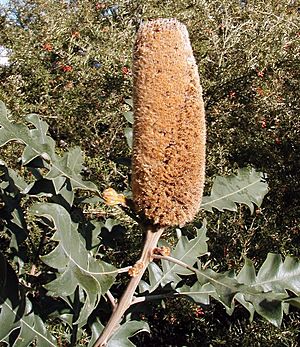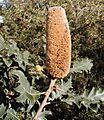Stirling Range banksia facts for kids
Quick facts for kids Stirling Range Banksia |
|
|---|---|
 |
|
| B. solandri, grown in Colac, Vic. | |
| Scientific classification | |
| Kingdom: | |
| (unranked): | |
| (unranked): | |
| Order: | |
| Family: | |
| Genus: | |
| Species: |
B. solandri
|
| Binomial name | |
| Banksia solandri |
|
| Synonyms | |
|
B. hookeri J.Drumm. |
|
The Banksia solandri, also known as the Stirling Range banksia, is a special type of large shrub. It belongs to the plant group called Banksia. You can only find this amazing plant growing in the wild within the Stirling Range in southwest Western Australia. Its scientific name honors a famous botanist named Daniel Solander, who was one of the first people to collect Banksia plants for science.
Contents
What Does the Stirling Range Banksia Look Like?
The Stirling Range banksia is a woody shrub that can grow up to 4 meters (about 13 feet) tall, which is like a small tree! It has big, wide leaves with jagged edges, similar to a saw blade. Its stems are thick and covered in fine fur. This plant blooms in spring and early summer, showing off its fawn-colored (light brownish-yellow) flowers.
The Story Behind Its Name
The Banksia solandri was first collected by a botanist named William Baxter near a place called King George Sound. Later, in 1830, another famous botanist, Robert Brown, officially described and named the plant.
The plant was named after Daniel Solander. He was a student of the famous scientist Carl Linnaeus and traveled with Joseph Banks on Captain James Cook's first big voyage. Daniel Solander was important because he collected some of the very first Banksia specimens that scientists ever studied!
Later, in 1847, the plant was found again in the Stirling Ranges by James Drummond. He thought it was a new species and even gave it a different name, "Banksia hookeri". However, scientists later realized it was the same plant as Banksia solandri.
Scientists today use modern methods, like studying the plant's DNA, to understand how different Banksia species are related. These studies show that Banksia solandri is most closely related to the Banksia grandis.
Growing Stirling Range Banksia
The Stirling Range banksia is a beautiful plant that can be grown in gardens. However, it is very sensitive to a plant disease called dieback. This disease can make the plant sick and even kill it.
Luckily, gardeners have found a clever way to help it! They can graft it onto another type of banksia called Banksia integrifolia. Grafting means joining parts of two plants together so they grow as one. The Coast banksia is much stronger against dieback, so it helps the Stirling Range banksia survive.
This plant's unique leaves make it a lovely addition to a garden. It grows best in a sunny spot with soil that drains water well. If you want to grow it from seeds, you don't need to do anything special to them. The seeds usually sprout within 36 to 71 days.
Images for kids


